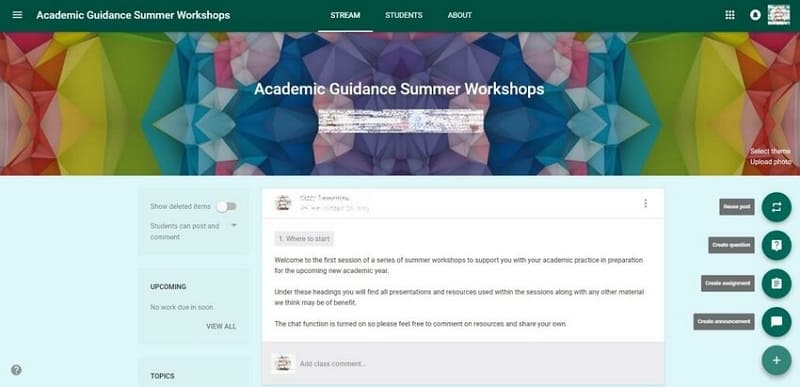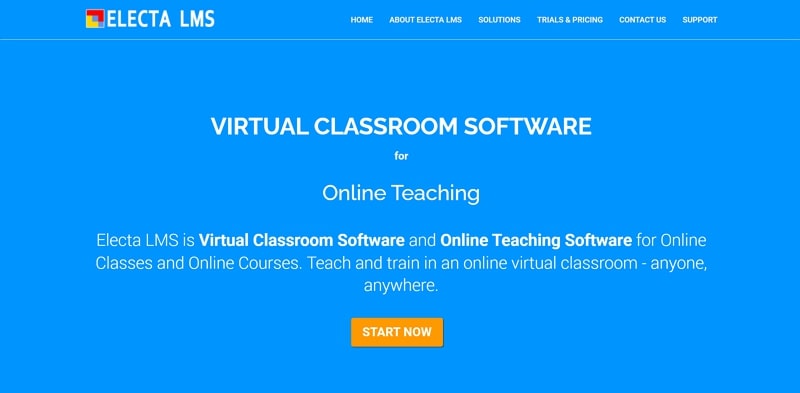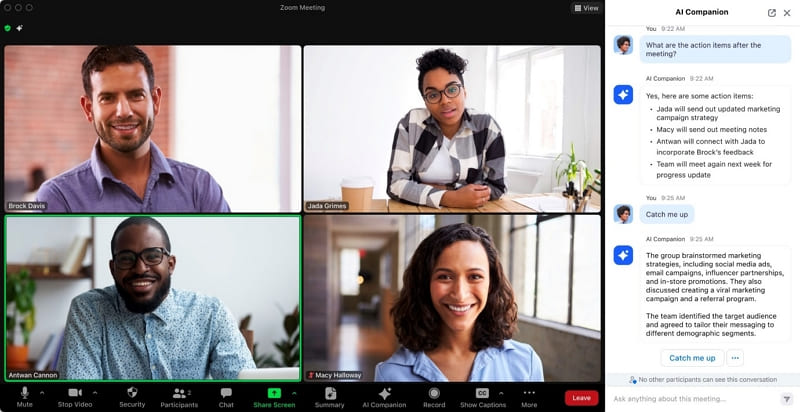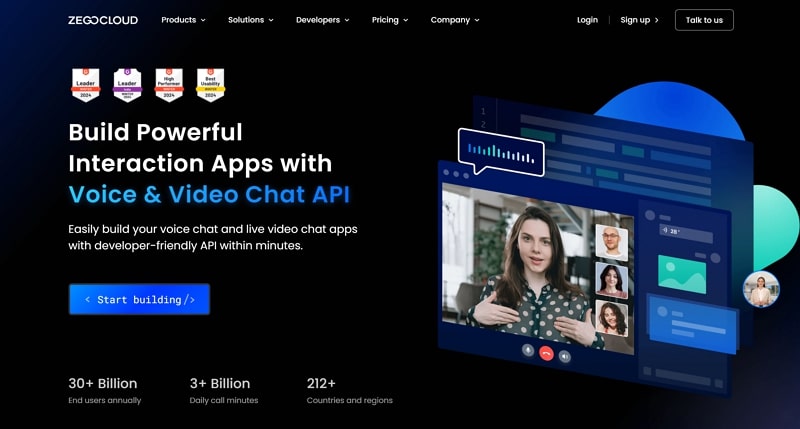Online learning has emerged as a safe and accessible option for continuing educational activity during the pandemic. Seeing the growth of virtual classrooms even after COVID-19, analysts expect the online education market to surpass $330 billion by 2026. Therefore, major educators will enter the e-learning industry, leading to the development of more virtual classroom systems. Read this article to learn more about this trending education medium.
What is a Virtual Classroom?
While talking about this online learning platform, a virtual classroom provides an e-learning environment that simulates a physical classroom. Apart from that, this online medium allows students and instructors to interact in real-time or asynchronously to facilitate flexible learning sessions. Through video conferencing software, students and teachers can see and hear each other for face-to-face discussions.
Besides, instructors can share various types of content, such as documents and videos, while carrying out these interactive classes. Surprisingly, you also get the option to share a screen and whiteboard for more interactive teaching. All in all, virtual classroom software does its best to develop a familiar atmosphere for remote students.
Features of A Virtual Classroom
You must be wondering what a virtual learning platform looks like. To solve your confusion, we will discuss the necessary features a virtual classroom platform should have for optimized working. You can go through each of these features one by one to fully comprehend what is a virtual classroom.
- Interactive Whiteboard: A basic online learning platform should have a whiteboard functionality to let teachers and students write and interact simultaneously. Other than that, this feature needs to support images, videos, and other media to make lessons more engaging for students.
- Video Conferencing: As we know, real-time interactions are essential for this system, so visual classrooms should ensure high-quality audio and video communication. Plus, these learning platforms must allow students to have group discussions and carry out collaborative projects.
- Chat and Messaging: An ideal virtual reality classroom should facilitate classroom-wide discussions and private conversations. However, they also need to have moderation tools to help in managing the flow of conversation.
- Content Sharing: Within an e-learning platform, the file upload and download features are a must for easy sharing of documents and other resources. Apart from that, these platforms should let teachers share their screens to demonstrate concepts in real time.
- Interactive Assessments: There should be quizzes and polls present in virtual classrooms to allow teachers to test students’ understanding. Moreover, an ideal online class will have gamification elements to motivate and increase student participation.
Virtual Classrooms vs Hybrid Classrooms vs Traditional Classrooms
As discussed, online learning platforms have features that make them much more accessible than other education mediums. By comparing them side by side with different forms of classrooms, we can better understand the functionality of these virtual classroom systems.
| Metrics | Virtual Classroom | Hybrid Classroom | Traditional Classroom |
|---|---|---|---|
| Location | When talking about an e-learning platform, the classes are entirely online, so you don’t have to visit a university or college. | In contrast, a hybrid system provides a combination of online and physical attendance. | However, students must regularly visit their school or college to attend these classes. |
| Flexibility | High | Moderate | Fixed Schedule |
| Interaction | Within virtual classrooms, student-teacher interaction is carried out through video and chatrooms. | A hybrid system offers a mix of virtual and face-to-face interaction. | Students can enjoy face-to-face interaction with their fellows and teachers during physical classes. |
| Cost | Lower | Moderate | Higher |
| Learning Pace | Students can learn at their own pace with synchronous and asynchronous elements. | While studying in the hybrid classroom system, you can enjoy a mixture of self-paced and scheduled sessions. | On the other hand, students have to study at a fixed pace determined by the teacher. |
| Environmental Impact | Lower | Moderate | Higher |
| Social Interaction | Limited | Mixed | High |
| Assessment Methods | Online quizzes, assignments, and exams. | Combination of online and physical assessments. | Traditional exams, quizzes, and assignments. |
Top 3 Virtual Classroom Examples
Keeping in view the accessibility of online classrooms, many universities and e-learning platforms have developed this system for a student-friendly environment. An e-learning classroom system is capable enough to deliver any form of education to students within a remote setting. Let’s analyze different types of virtual classroom examples to see what kinds of programs are taught through these systems.
1. MOOC (Massive Open Online Courses)
With this example of a virtual classroom system, online e-learning sites accommodate a large number of participants for an accessible learning experience. Surprisingly, these classrooms are open to anyone with an internet connection and feature materials from universities and institutions worldwide. Other than that, these courses are usually self-paced or have scheduled start and end dates.
Moreover, you get access to forums and discussion boards for student interaction and peer support. For example, Coursera offers certification and courses in fields such as data science and digital marketing.
2. Synchronous Virtual Classrooms
When discussing this type of online learning, we can say that it involves real-time interactions between teachers and students. Moreover, these virtual classes occur at scheduled times, similar to traditional classrooms. To ensure smooth live communication, e-learning platforms take help from video conferencing tools.
Other features like chat, polls, and breakout rooms further facilitate interaction between students and instructors. Educators commonly use platforms such as Zoom and Microsoft Teams to conduct these online virtual classroom sessions.
3. Competency-Based Virtual Classrooms
Such online classrooms focus on students achieving specific skills and competencies rather than progressing through a course based on time. Therefore, students advance once they demonstrate mastery of the subject matter. During the course, trainers carry out frequent assessments to measure competency and provide feedback to the students.
For instance, Western Governors University offers online degree programs that allow students to progress through the curriculum at their own pace. Moreover, their educational progress is entirely based on their ability to demonstrate mastery of the material.
What Do You Need for a Virtual Classroom?
Consequently, we will now discuss the things you will require for an optimized learning session on a virtual classroom platform. After arranging all these hardware and software-related elements, you will be all set to take a virtual class.
- Hardware: To start with, you will need a reliable computer with sufficient processing power to run various virtual classroom applications smoothly. Other than that, a stable internet connection is crucial for streaming video and participating in real-time discussions without interruptions or lag. Plus, you should also arrange a webcam and microphone for an interactive session.
- Video Conferencing Tools: In addition, students will need a video communication tool, such as Zoom and Google Meet. Irrespective of the tool you select, it must have advanced features like screen sharing, video recording, and chat for an ideal virtual classroom system.
- Content Creation and Sharing Platforms: Students should also have access to online storage and sharing platforms, such as Google Drive. These platforms make the assignment and document-sharing process much easier.
- Learning Management System: With the help of proper LMS, you get a system that is capable of handling processes, including assignment submission, grading, and progress tracking. Moreover, an ideal virtual classroom setup will include discussion forums for collaborative learning.
5 Best Virtual Classroom Apps and Platforms
For an interactive session, you will need the best virtual classroom software to manage all your educational activities in one place. So, we have identified the most advanced virtual classroom platforms to let you experience an optimal learning environment.
1. Google Classroom

Using this online learning platform, teachers can customize classwork for each student and offer them real-time feedback on the work. Moreover, you can provide individual guidance to the students with the help of AI-powered prompts and hints.
With its analytics feature, educators can keep an eye on each student’s performance. So, teachers can assign and grade multiple classes at a time using its software version or mobile apps.
2. LearnCube

Teachers can use this virtual classroom software to interact with their students through video and audio conferencing. Moreover, this tool even has an interactive whiteboard that lets you write or draw while conducting an online class.
Using this virtual classroom, you can easily upload and access multimedia content for assignment sharing. Surprisingly, students can even record online sessions to benefit from them during revision.
3. Electa LMS

With the help of this online teaching software, educators can create courses and tutorials to help students get easy access to education. Other than that, you can conduct live online classes and one-on-one tutoring sessions for an interactive learning experience.
You can download its offline version to get access to advanced whiteboard and screen-sharing features. Also, teachers can utilize this software to assign and grade quizzes for a quick assessment.
4. Zoom

Commonly, you can utilize this virtual classroom platform to streamline video communication for any use case. However, with features such as whiteboard and notes, this tool is tailor-made for conducting online classes.
Apart from that, teachers can utilize its team chat feature to conduct an interactive learning session for a large number of students. Now, this tool is integrated with an AI companion, allowing students to summarize the whole teaching session.
5. Adobe Connect

Students can enjoy an asynchronous and real-time learning session with its advanced features. While conducting a virtual classroom, you can benefit from its moderated chat to interact with the students.
Other than that, you can benefit from its drawing and annotation tools to deliver an engaging class on the online whiteboard. Most importantly, you can change virtual classroom backgrounds to conduct a class from anywhere without worrying about the surroundings.
How to Choose a Virtual Classroom System?
Now, let’s shift our discussion towards things to consider while choosing the most appropriate virtual classroom software for your educational needs. All these points will provide you a blueprint on how to select the best e-learning system to conduct an optimized online session.
Identify Your Needs and Goals
As a seasoned educator, you need to first determine who will be using the virtual classroom system. Upon choosing the target students, teachers should define the learning objectives and outcomes they aim to achieve with the online classroom. Other than that, we recommend considering the number of participants to ensure the system can handle the capacity.
Look for Specific Key Features
Students and teachers should assess an online learning platform for the following features before conducting virtual classes.
- Video Conferencing: Firstly, they should ensure the system offers high-quality video and audio capabilities for live interactions.
- Recording and Playback: Other than that, we recommend looking for an ability to record sessions for students to review later.
- Screen Sharing: Teachers should go for a virtual classroom platform that allows them to share screens for presentations and demonstrations.
- Interactive Tools: Before selecting a virtual class system, you need to check for additional features like chat, polls, and whiteboards to engage students.
- Content Management: An ideal online learning platform should also facilitate the easy upload and organization of course materials.
Check for Usability Properties
We recommend you choose a platform with an intuitive and user-friendly design for both teachers and students. Other than that, teachers must ensure the platform is accessible to all students, including those with disabilities. Most importantly, you should pick an e-learning platform that allows you to access the virtual classroom on various devices.
Consider Cost and Budget
Before selecting an online classroom system, you need to understand the pricing model and ensure it fits within your budget. According to our research, subscription-based models are mostly suitable for students, as they are only required to pay when they want to access any online course. However, you should remain aware of additional costs, such as extra features, upgrades, or support services.
Build Interactive Virtual Classrooms with ZEGOCLOUD
Educators who want to expand their services globally should look to establish their virtual classroom platform. To do so, you can benefit from the services of ZEGOCLOUD, as it provides communication APIs and SDKs for real-time interactions.

With these APIs, you can carry out online learning classes with ultra-low latency for a smooth user experience. Moreover, its video-call SDKs allow you to conduct one-on-one tutoring sessions without lag.
Whether you want to conduct music classes or language training, this platform integrates high-quality video and audio-conferencing features within your teaching application. Using its API, teachers can even provide record and playback features within their virtual classroom. Teachers looking to reach out to a wide range of students can make use of the live-streaming APIs provided by ZEGOCLOUD.
Final Thoughts
In conclusion, we can say that virtual classroom systems are emerging as the future of the education industry. Both students and teachers can benefit from such an e-learning platform to get easy access to their desired courses and target learners, respectively.
If you also want to integrate communication features into your virtual classroom, we recommend you seek help from ZEGOCLOUD. With its excellent APIs, you will be able to interact with students globally through video conferencing and live streaming features.
Read more:
Let’s Build APP Together
Start building with real-time video, voice & chat SDK for apps today!










